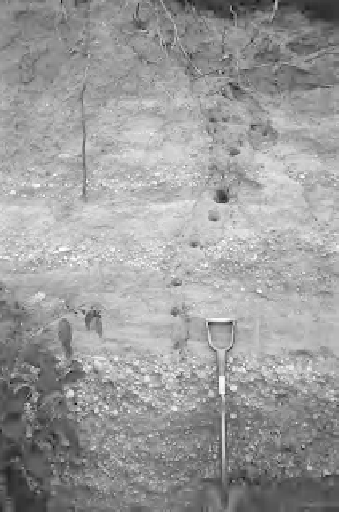Geology Reference
In-Depth Information
Figure 12.3.
2.7 m deep and 5-20 cm wide, containing
well-sorted and wind-abraded fi ne sand dated by OSL at
Late-Pleistocene sand-wedge structure,
∼
65 ka, formed within indurated
Late-Tertiary gravel (Bridgeton Formation), Cumberland County, Southern New Jersey, Eastern
USA.
>
thaw of the non-icy infi ll material does not allow secondary material and the cast retains
much of its original sedimentary structure. A photograph of a sand-wedge cast developed
in sand and gravel is illustrated in Figure 12.3. By comparison, a composite wedge consists
of a mixture of both primary and secondary infi ll (Figure 12.4), and shows an inner wedge
of primary fi ll and an outer wedge showing signs of secondary fi ll. In this case, the fi ssure
was initially fi lled with a mixture of sand and ice but the ice amount was so small that the
foliated structure was not destroyed upon thaw.
Sand-wedge casts are sometimes thought to refl ect colder conditions than ice-
wedge pseudomorphs (Murton and French, 1993a). This is not the case because fi eld
experience demonstrates that all types of fi ssures can form in the same geographical area.
Local site characteristics, exposure to wind, the availability of wind-blown sediment,
and drainage conditions all infl uence the nature of the fi ll material. It is not surprising,
therefore, that observations in western Jutland, Denmark, indicate that ice-wedge pseu-
domorphs, sand-wedge casts, and composite-wedge casts all exist in the same area
(Kolstrup, 1987).
Thermal-contraction cracking leads to the development of large-scale polygonal pat-
terns at the surface. These are sometimes recognized on air photographs by differences
in vegetation or crop ripening (Figure 12.5). However, only the most recent features are
usually identifi ed, and older polygon nets may be buried by more recent sediments. Based
upon the distribution of polygons and frost-fi ssure casts and pseudomorphs in Western

